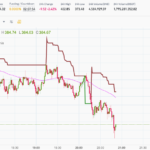In the world of financial markets, traders and analysts constantly seek reliable methods to predict price movements and identify potential areas of support and resistance. Among the myriad of technical analysis tools available, Fibonacci retracement has emerged as a popular and intriguing approach. Derived from the mathematical Fibonacci sequence, this method leverages the inherent harmony found in nature to identify significant levels for potential trend reversals. In this article, we will delve into the principles behind Fibonacci retracement, its applications, and its limitations, shedding light on its role in modern market analysis.
- Understanding the Fibonacci Sequence : The Fibonacci sequence is a series of numbers where each number is the sum of the two preceding numbers. The sequence begins with 0 and 1 (or 1 and 1, depending on the source), and it extends infinitely. Therefore, the sequence starts as follows: 0, 1, 1, 2, 3, 5, 8, 13, 21, 34, and so on. This sequence has fascinated mathematicians and scientists for centuries due to its numerous appearances in nature, art, and even financial markets.
- Fibonacci Retracement: The Basics: Fibonacci retracement is a technique that involves drawing horizontal lines at key levels based on the Fibonacci sequence, namely 23.6%, 38.2%, 50%, 61.8%, and 78.6%. These levels are then used to identify potential areas of support and resistance during price corrections within an overall trend. Traders believe that these levels represent natural areas where market participants may enter or exit positions, leading to a temporary pause or reversal in the price action.
- Applying Fibonacci Retracement in Market Analysis: To apply Fibonacci retracement, traders first identify a significant price swing in an asset’s price chart. This swing can be either upward or downward, depending on the trend being analyzed. The tool is then applied by anchoring the retracement levels at the swing’s high and low points.
When an asset is in an uptrend, traders anticipate a retracement by drawing the Fibonacci retracement levels from the swing’s low point (0%) to its high point (100%). Conversely, during a downtrend, traders reverse the process and draw the levels from the swing’s high point to the low point. These retracement levels act as potential support or resistance zones, suggesting where the price might find stability or experience a reversal.
Traders often combine Fibonacci retracement levels with other technical indicators, such as trendlines, moving averages, or oscillators, to strengthen their analysis. This technique aids in identifying confluence zones where multiple indicators align, increasing the probability of price reversals or continuations.
- Limitations and Criticisms of Fibonacci Retracement: Despite its popularity, Fibonacci retracement has its share of criticisms and limitations. Some argue that the choice of the Fibonacci levels is subjective and depends on the individual trader’s interpretation. Additionally, markets are influenced by various fundamental factors, which can override the significance of Fibonacci retracement levels. It is important to acknowledge that the effectiveness of Fibonacci retracement can vary across different financial instruments and timeframes.
Conclusion:
Fibonacci retracement provides traders with a structured approach to identify potential levels of support and resistance within a given trend. Its basis in the Fibonacci sequence, a mathematical phenomenon observed in nature, lends an aura of reliability to the method. While Fibonacci retracement is not infallible and must be used in conjunction with other analytical tools, its wide acceptance in the trading community showcases its value as a supplementary technique for market analysis. By understanding Fibonacci retracement, traders gain an additional perspective on price action, empowering them to make more informed decisions in the dynamic world of financial markets.






